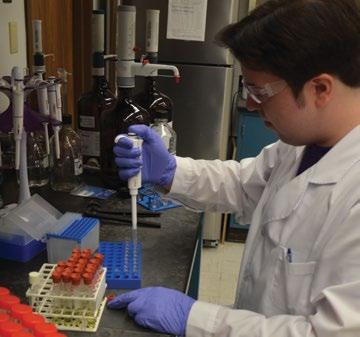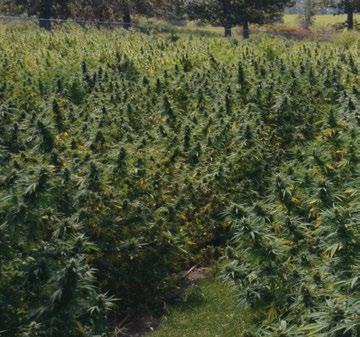
4 minute read
Hemp is Happening
from Arkansas Grown
Researchers Harvest Arkansas’s First Legal Hemp Crop in Decades
Arkansas’s first legal industrial hemp harvest in 80 years was a mixed success in 2019, leaving hemp farmers with some answers but many more questions as they enter the second year of a state-authorized research pilot program. Despite the mixed success, interest seems very high for the next season.
Advertisement
“I want to do my part to help farmers with a new and confusing crop,” he said. “I feel like I have many roles as a program manager: I try to be a reality check to our growers, keep them from unnecessary entanglements with the law, and help them make industry connections where I can.”
The 2014 Farm Bill legalized the growing and cultivating of industrial hemp for research purposes in states where hemp growth and cultivation is legal under state law. In 2017, the Arkansas General Assembly passed the Arkansas Hemp Act that authorized the Arkansas Department of Agriculture to develop an industrial hemp research pilot program. In 2019, 125 farmers and 33 processors were licensed to participate in Arkansas’s research pilot program. Industrial hemp, as defined by law, is any variety of the Cannabis sativa L. plant with a delta-9 tetrahydrocannabinol (THC) concentration of 0.3% or lower. Plants with a THC concentration higher than 0.3% are considered illicit marijuana, a controlled substance, and must be destroyed. The industrial hemp research pilot program is intended to provide Arkansas growers with key insight into growing industrial hemp in Arkansas’s unique climate, from identifying the best soils and fertilizer to determining the amount of sunlight or heat that may cause stress on the plant. THC levels will elevate in the plant as it matures, and stress can cause the levels to spike. THC above 0.3% effectively renders a plant unmarketable. Caleb Allen, the hemp program coordinator for the Arkansas Department of Agriculture, oversaw the first year of the project. Allen says his role as the program coordinator has been extensive and quite varied. Farmers growing industrial hemp must notify the Arkansas Department of Agriculture when they are ready to harvest, and in turn, the department’s lab must measure a representative sample of the crop for THC content. Allen, as the hemp program coordinator, makes decisions based on lab results about which crops need to be destroyed for program-compliance, and which crops can be marketed to a licensed hemp processor. Of the 1,820 acres planted in the state in 2019, only 842.8 acres were harvested. Growers ended up destroying over 236 acres due to various causes. “This is a brand-new crop that has been illegal for eight decades. Now Arkansas farmers are trying to figure out what to do with it,” Allen said. “A lot of people see benefits and dollar signs when they think of industrial hemp. Not everyone saw dollar signs this first year. Take the farmer who invested $5,000 in hemp seed, yet not one seed germinated,” Allen said. Farmers licensed to grow hemp through the Arkansas Department of Agriculture are required to conduct a research project into an aspect of hemp growth and cultivation. In turn, Allen and his team will compile and share data among licensed growers and regulators. “There’s a lot of planting failure overall because it’s new and because we don’t have adequate education and research,” Allen said. “It’s a lot of lessons learned, “This is a brand-new crop that has been illegal for eight decades. Now Arkansas farmers are trying to figure out what to do with it.”
Allen is confident that research conducted in 2019 and 2020 will be beneficial toward determining how to manage the state’s burgeoning hemp crop.
“Farmers who have years of agricultural experience all say the same thing: ‘Hemp is a different beast.’ They’re stumped and they don’t know what to do at times,” Allen said. “The crop was portrayed as easy to grow, and that it can grow anywhere. Many of our growers found that not to be the case. It turns out hemp is a finicky plant that needs to be carefully maintained and treated to achieve a successful crop. Extensive planning and coordination are required. Hemp farmers must face all the uncertainty with the weather, environment, and market that other farmers do, while also potentially losing their crop if THC levels run too high.”
“More than 95% of this year’s hemp crop was grown for use in cannabidiol, or CBD, products,” Allen said.

There are other uses for hemp. When growing hemp for fiber, the plant stalk is used instead of the flower. It’s supposedly easier to grow hemp for fiber or grain, but the current market for CBD oil is more lucrative.
On October 31, 2019, the United States Department of Agriculture (USDA) published the Final Interim Rule for the U.S. Domestic Hemp Program, leading the nation into the commercialization of hemp. Under the Final Interim Rule, all states and tribal territories must declare their intent to have oversight of hemp grown in their borders. The USDA will take responsibility for hemp in states and territories that choose not to develop their own programs. All states and tribal territories, including Arkansas, will have until October 31, 2020, to decide whether to administer their own program or forfeit the responsibility to the USDA.











